Notable
Consumer Product Award
Core77 Design Awards 2015
BioLite BaseCamp
The BioLite BaseCamp is a complete off-grid cooking and energy solution for groups, powered by wood. Using only fallen branches or small pieces of firewood, you can make wood-fired meals and charge your devices all at the same time. It's a smart alternative to fossil-fueled stoves, creating an elevated cooking fire that burns smarter than any campfire you're used to. It uses BioLite's core thermoelectric technology to convert heat into 5 watts of usable electricity which powers an internal fan for highly improved combustion.
The BioLite BaseCamp is a product years in the making. When BioLite took its flagship product, the BioLite CampStove, to a wood combustion conference in 2009, we quickly realized that the application for our technology went far beyond outdoor recreation. Half the planet still cooks on smoky open fires, killing more people annually than AIDS, TB, and Malaria combined. This motivated our team to develop the BioLite HomeStove, a low-cost biomass cookstove that dramatically reduces emissions while co-generating usable electricity. The HomeStove was the winner of the 2013 Core77 Awards in the Social Impact category.
Our users in the outdoor recreation and emergency preparedness markets have been incredibly supportive of our HomeStove work, but many also let us know over the years that they too were interested in the larger stove. So we got to work on developing a new consumer product - and that's how the BaseCamp was born.
This was a unique project for BioLite as it was the first product to be developed directly from customer feedback. As a crowd-demanded idea, BioLite decided to launch BaseCamp on Kickstarter in May 2014 to make it a crowd-funded reality. Through Kickstarter, BioLite was empowered to tell a long-form story of the BaseCamp's design process and enumerate its differentiated feature set. This helped potential supporters understand what goes into developing a functional, valuable product and why we did not just simply launch the HomeStove in the outdoor recreational market (more on that in the project details below). BioLite hit its its initial goal within three hours of launching and went on to raise over $1MM dollars, becoming one of the most successful Kickstarter campaigns of all time.
The BioLite BaseCamp is a welcome member of the BioLite family of products, offering approachable wood cooking to families and groups while simultaneously creating a heightened visibility into BioLite's mission to bring Energy Everywhere.
 BioLite BaseCamp in Use
Included Flexlight illuminates cooktop in lowlight conditions
Matthew Land
BioLite BaseCamp in Use
Included Flexlight illuminates cooktop in lowlight conditions
Matthew Land
 BioLite BaseCamp Cooking
BioLite BaseCamp, a larger counterpart to the BioLite CampStove, can feed large groups using nothing but wood.
Matthew Land
BioLite BaseCamp Cooking
BioLite BaseCamp, a larger counterpart to the BioLite CampStove, can feed large groups using nothing but wood.
Matthew Land
 BaseCamp Development
Early phase analysis of how to modify HomeStove body to accommodate a larger cooktop that effectively distributed heat and did not compromise combustion efficiency.
BaseCamp Development
Early phase analysis of how to modify HomeStove body to accommodate a larger cooktop that effectively distributed heat and did not compromise combustion efficiency.
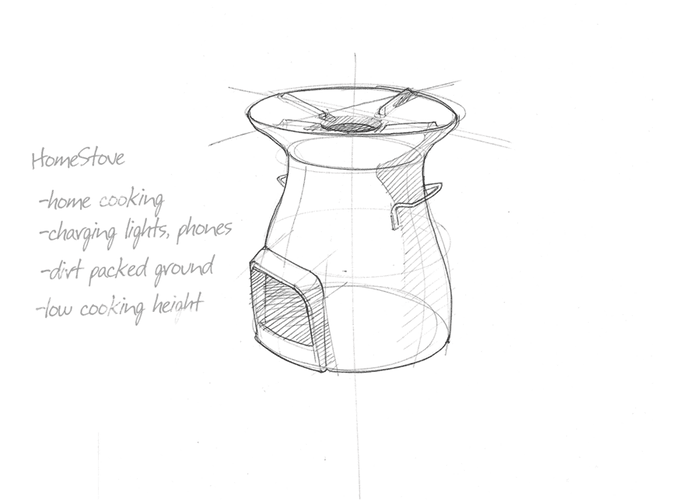 More than a retrofit
The BaseCamp uses the same central body of the HomeStove but incorporates several material changes and functionalities designed specifically for the recreational user. Just as we designed the HomeStove for a specific user, we wanted the BaseCamp to have the same focus.
More than a retrofit
The BaseCamp uses the same central body of the HomeStove but incorporates several material changes and functionalities designed specifically for the recreational user. Just as we designed the HomeStove for a specific user, we wanted the BaseCamp to have the same focus.
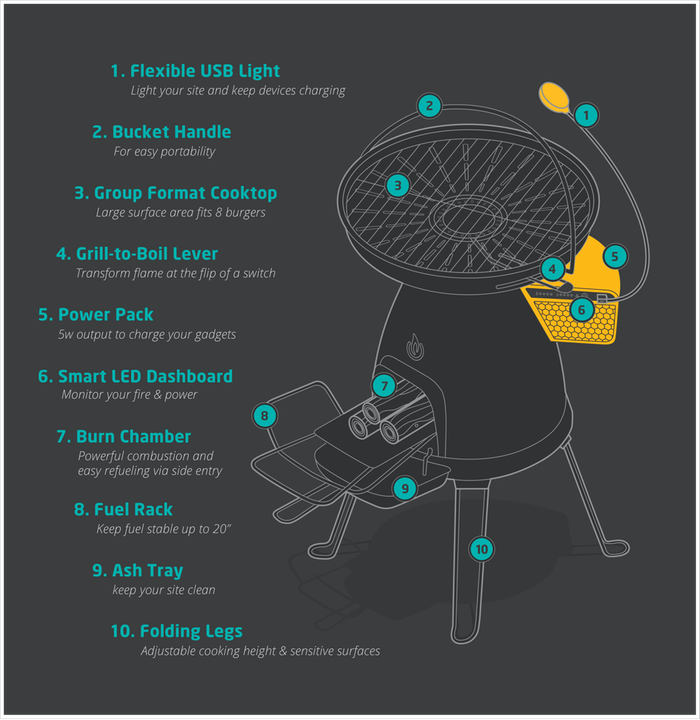 BaseCamp Feature Set
BaseCamp Feature Set
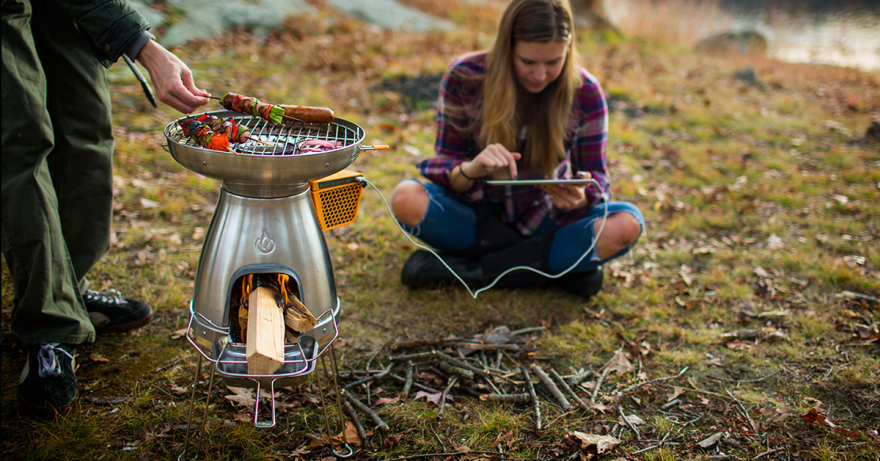 BaseCamp TEG Stove
The BaseCamp generates 5W of useable electricity, enough to power personal devices like an iPad
Tory Williams
BaseCamp TEG Stove
The BaseCamp generates 5W of useable electricity, enough to power personal devices like an iPad
Tory Williams
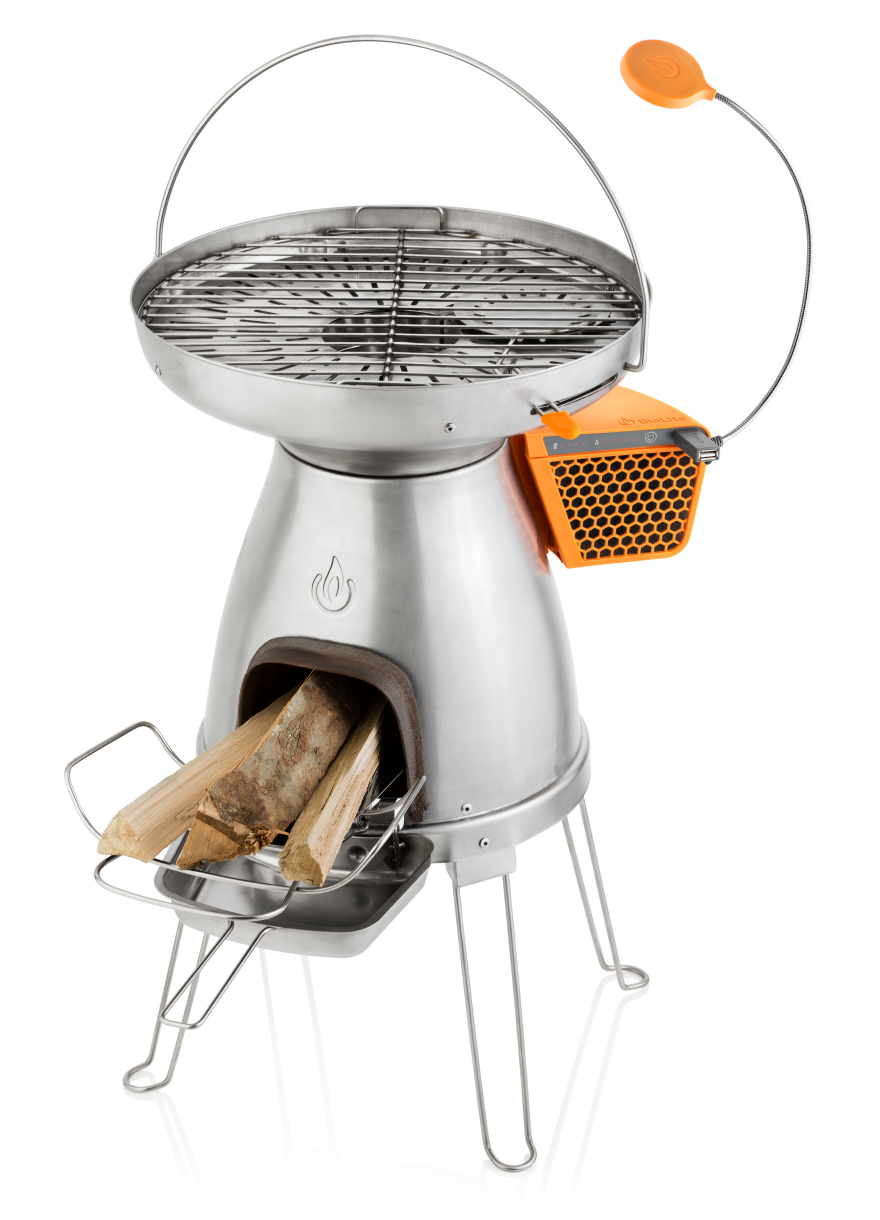 BioLite BaseCamp
Final design in markets worldwide
BioLite BaseCamp
Final design in markets worldwide
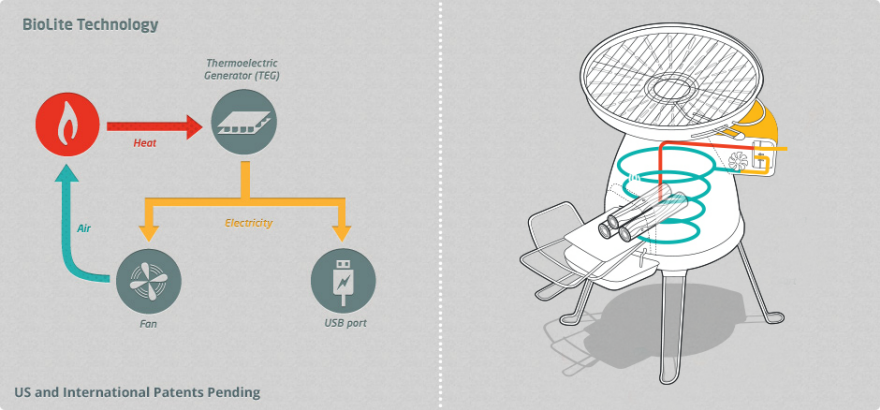 BioLite Technology
BaseCamp uses BioLite's patented technology, using a TEG to convert waste heat from the fire into useable electricty. This powers a fan that gasifies the wood, allowing users to cook as cleanly as with fuel canisters. Surplus electricity is sent to a USB port for charging small devices.
BioLite Technology
BaseCamp uses BioLite's patented technology, using a TEG to convert waste heat from the fire into useable electricty. This powers a fan that gasifies the wood, allowing users to cook as cleanly as with fuel canisters. Surplus electricity is sent to a USB port for charging small devices.
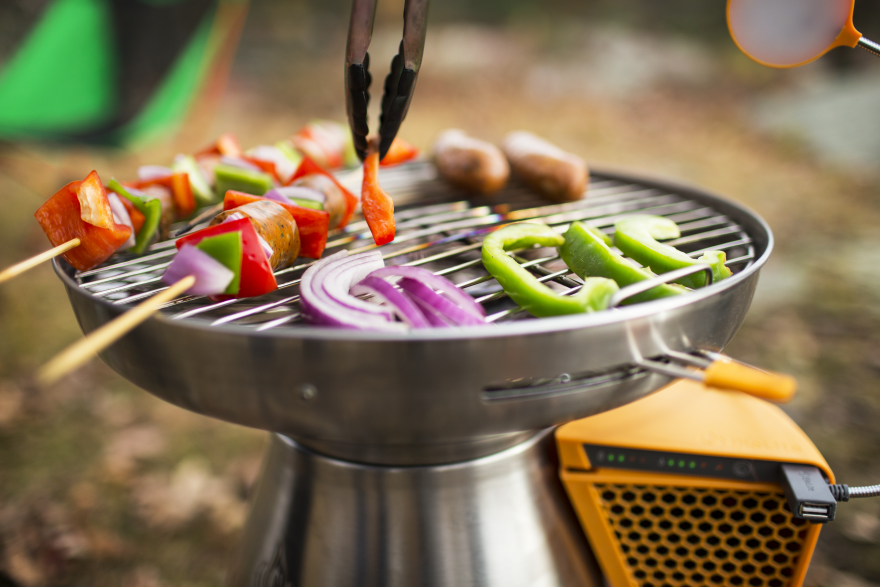 Cooking and Grilling
The cooktop can grill foods or be a burner for pots and pans with the flip of a lever
Cooking and Grilling
The cooktop can grill foods or be a burner for pots and pans with the flip of a lever
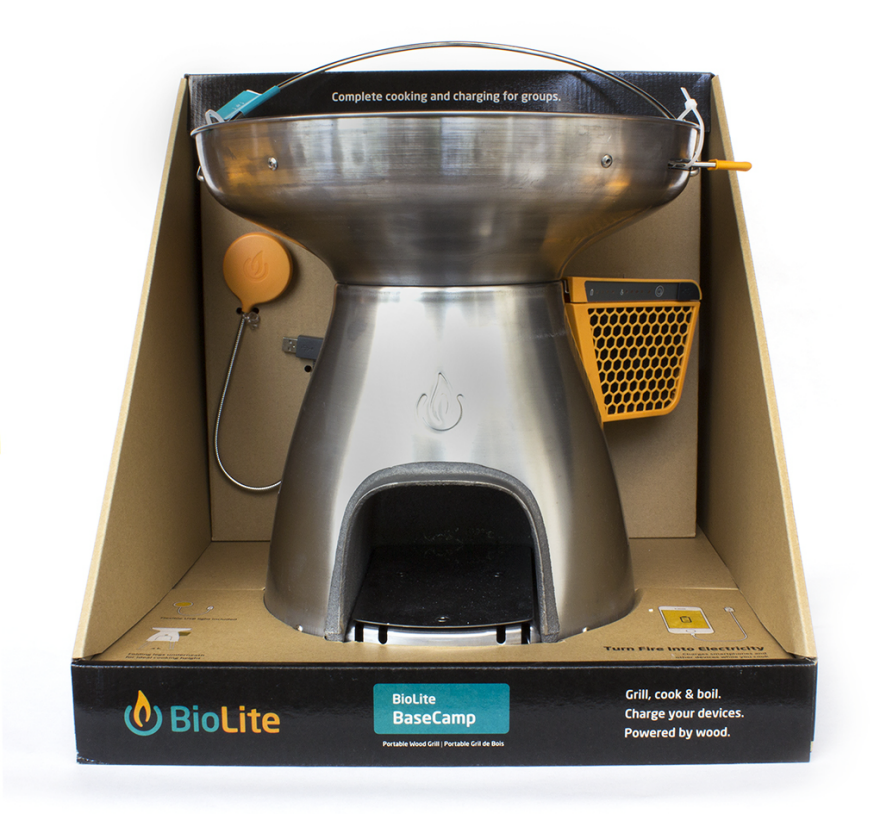 BioLite BaseCamp Packaging
Open face packaging provides compelling point-of-purchase display for the product without the need of additional retail signage.
BioLite BaseCamp Packaging
Open face packaging provides compelling point-of-purchase display for the product without the need of additional retail signage.
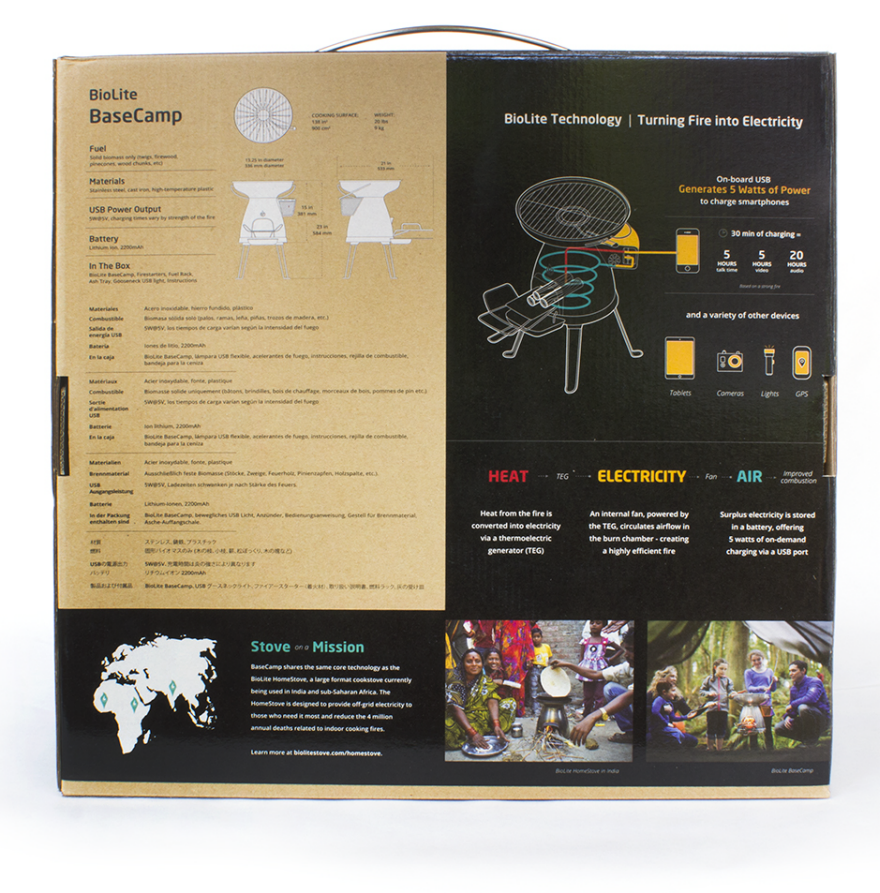 BaseCamp Package, back view
Back view of the BaseCamp packaging - connects users with relevant product information and BioLite Mission. Creates understanding and excitement.
BaseCamp Package, back view
Back view of the BaseCamp packaging - connects users with relevant product information and BioLite Mission. Creates understanding and excitement.
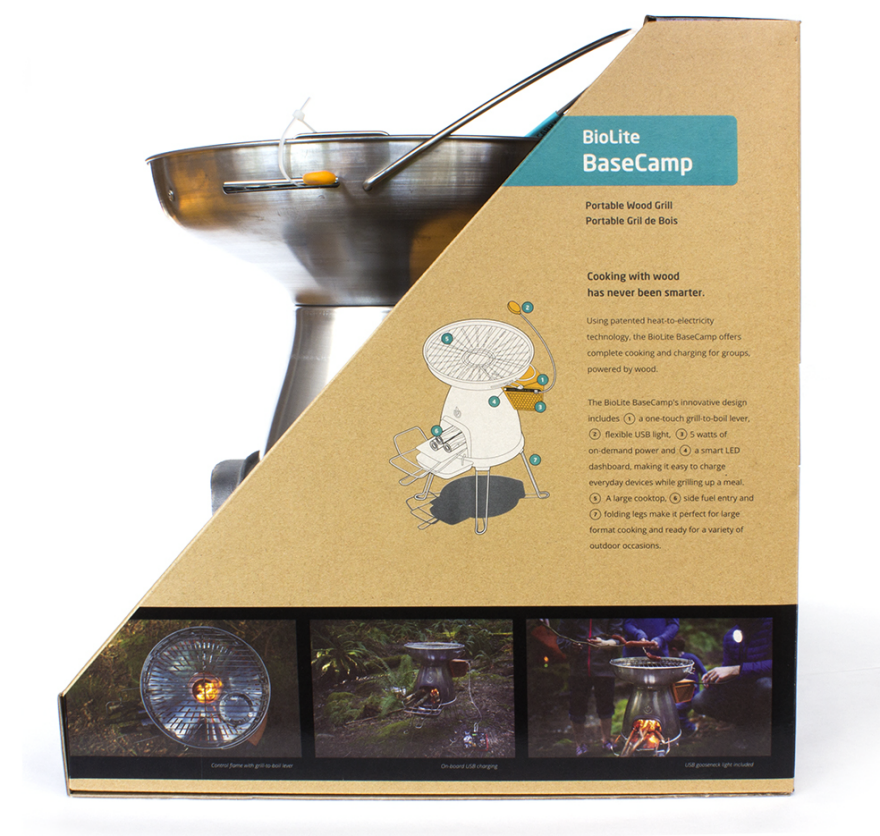 BaseCamp Packaging, Side
Side panels deliver helpful information and rich photography to show product in context as well as image of product with legs fully extended.
BaseCamp Packaging, Side
Side panels deliver helpful information and rich photography to show product in context as well as image of product with legs fully extended.
Origins of BaseCamp - The BioLite HomeStove Connection
The BioLite HomeStove is currently distributed across India and Sub-Saharan Africa and is at the core of BioLite's work in bringing clean energy access to families living in energy poverty.
"I want one too. Why not just produce more HomeStoves and sell them here?" This was a comment we heard a lot as people in developed markets learned of our HomeStove program. While at first blush it may seem like an easy win, at BioLite, we design products that focus on the needs of our customers. While there are many common needs between the emerging markets and off-grid outdoor recreation community, there are also several nuances to these respective experiences that make for very different final products. For example, dirt packed floors vs. a treated wood deck require different considerations when it comes to ember disposal or even just proximity to a hot surface. This goes way beyond a simple retrofit.
Design and Feature Considerations
As we worked on the design development of BaseCamp, we kept three core things in mind:
1. Group Access - How do we take the benefits of the BioLite CampStove and extend it to larger groups of people who want to be cooking in the outdoors together?
2. Improved Power - As electricity needs increase and more outdoor gear becomes USB-rechargeable, how can we provide more on-demand power when our users need it?
3. Usability and Portability - What design improvements can we incorporate to facilitate a fun cooking experience and an easy way to move the BaseCamp from point A to point B?
From these core criteria, BioLite was able to adapt the body of the HomeStove but then add the following key features for a compelling and relevant user experience for the outdoor market consumer:
a. Fold out legs to elevate the stove off the ground to better serve typical recreational cooking posture and protect floors/decks/grounds from hot surfaces
b. A grill (The HomeStove is more built for pots, but you can also use a pot on the BaseCamp) and larger cooktop for direct food contact
c. 5 watts of electrical output plus on-board storage if users wish to use their power when the fire is not live
d. An included USB powered flexible light to illuminate cooking surfaces in low-light or nighttime conditions. This directly came out real world observations and team experiments on camping trips.
e. A smart dashboard that provides real-time feedback to show how hot the fire is and how much electricity is being generated.
f. A bucket handle for easy transport
Engineering Consideration
Larger cooktop and more power; and easy request to make, but a challenging improvement to retrofit into an existing stove body. By creating a larger surface area on the BaseCamp, BioLite engineers were tasked with developing a design that removed the cast iron cooktop of the HomeStove and replaced it with a cooking surface that offered both boiling and grilling functionality while maintaining combustion efficiency. Secondly, they had to come up with a new PowerPack design to facilitate a higher power output and a more complex LED dashboard. Through multiple rounds of prototyping and iterative testing, the team was able to design a flame-spreading cooktop that effectively grilled or boiled depending on the placement of the central lever and did not adversely affect the airflow of the burn chamber. The Power Pack was extended to accommodate a new TEG (thermoelectric generator) configuration and the new design wrapped around the body of the stove to create a front-facing panel that allowed users to easily see the LED panel from their cooking vantage point.
Packaging Consideration
Once the Kickstarter project was successfully funded, retail partners expressed a strong desire to get the BaseCamp on shelves in stores. This was an exciting opportunity, but presented a new challenge for the BioLite team to tackle: how do you take the multimedia, long form experience and excitement of a Kickstarter Campaign and fit it onto a package? Furthermore, how do you design a structure for an oversize hardgood product that helps tell the story while serving the typical functional needs of presentation and protection?
With space at a premium in the retail environment, every square inch counts. This required BioLite to design for as small of a footprint as possible. Furthermore, out-of-packaging displays are highly effective to drive interaction, but cost-intensive to retailers. With these insights in mind, BioLite decided to build the display INTO the package itself. This resulted in an exposed front face (see uploaded pictures) that allows users to see the real product, immediately drawing them into the unique industrial design, the durable high quality materials, and providing direct visual access to key product features. The supporting sides of the package reinforce the value proposition of the product while communicating salient product information. The back panel connects the BaseCamp to its HomeStove origins, giving potential customers a sense of greater purpose and connection in their purchase.
Structurally, the BaseCamp packaging was put through several rounds of testing to ensure that the design could withstand international shipments, bumps and jostles, and the basic wear and tear of a retail environment. Through a stabilized bottom and reinforced back wall, this structure is capable of effectively supporting an 18 pound product while providing its own point-of-purchase display.
Parallel Innovation
Finally, the success of the BaseCamp Stove helps BioLite continue its unique business model of Parallel Innovation. By incubating core technologies in both outdoor and emerging markets, BioLite is able to re-invest the near term revenue generated by our recreational audience into long term market-building programs in energy impoverished geographies that need it most. Visibility of the BaseCamp immediately creates visibility for the HomeStove and the broader clean cookstove movement. When customers choose BioLite they are not just investing in a product; they are supporting a much larger mission with scalable impact that will benefit public health and curb climate change.
an excellent solution with far-reaching and meaningful applications